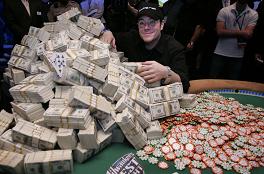|

Join our Newsletter
& get our free guide Starting Hands Revealed
We hate spam too!
We value your privacy and never share your email. All our emails have an opt-out link. Click it, and you will never hear from us again. |
Big Stack Tournament Strategy
Sometimes there are players who are timid with their big stacks and do not utilize them well, getting passed over by smaller stacks. Learn how to play a big stack in order to maintain your advantage toward the final table. Learn to use you Big StackAs a big stack, you are a threat to all smaller stacks at the table. You should bully the small or medium stacks, but avoid other big stacks if there are any at your table. Focus on the very small and the small stacks. Deploy an aggressive style that will rout your short-stacked opponents. The very small stacks are desperate. They can only fold or push allin. As a big stack, you must either test them by putting them all-in or call their desperate bets most of the time. Your decision to call their allin bets depends on the odds that you get and the relative size of your respective stacks. For example at a 9-handed table at Titan Poker, you have 40k in chips in the big blind, the very small stack in the button has 2k, the blinds are 150/300, the ante is 25 and the button is first in the pot and raises allin. Calling costs you 1,675 or about 4% of our stack, i.e. there is no risk in calling. The pot is 2,650 so you need to win at least 39% of the time for calling to have positive EV. Note that it would be ok to call even with about 35% chance of winning instead of 39%, because the benefit of eliminating one player plus having an even bigger stack more than compensate for the risk of losing this bet and having a slightly smaller stack. Assuming that the very small stack's range for making this push is {any ace, any pair and any face card}, a random card has 38.5% pot equity against his range. So you should almost always call in this situation. What we define as small stacks are stacks around 10k in chips in our example, and not larger than 20k, so the worse case if you lose a big pot against one of them is that you lose half your stack. You must bully them, steal blinds from them and raise them at times. The following techniques against short stacks are suggested: 1- steal small stack blinds from any position in unopened pots, These attacks should be focused on weak-tight players if possible. Avoid the players who like to play back at you. In order to be most effective, you must switch gear occasionally otherwise your strategy will be too transparent and it will generate more resteal attempts from players who want to take a stand. Stay quite for a while and then attack pots aggressively for one or two orbits, then lean back a bit. With respect to other big stacks, avoid confrontation with them as much as possible. Unless you must win the tournament or you have the nuts, there is no need to attempt doubling up with a big stack. Leave your pride aside if another big stack shows aggression and focus on the low hanging fruit instead. Practice your big stack strategy at our selection of the best online poker rooms. These poker sites offer plenty of online poker tournaments at all hours of the day, with many chances to make a killing if you know how to maneuver with a big stack. |




 Sitting in front of a big stack is the dream in tournament poker, obviously! But there are
players who reach a big stack rapidly, just to lose it as quickly.
Sitting in front of a big stack is the dream in tournament poker, obviously! But there are
players who reach a big stack rapidly, just to lose it as quickly.






